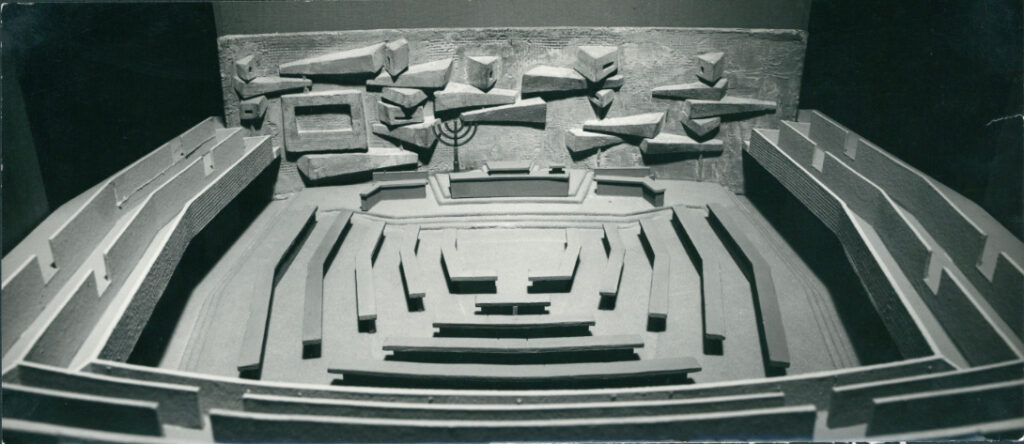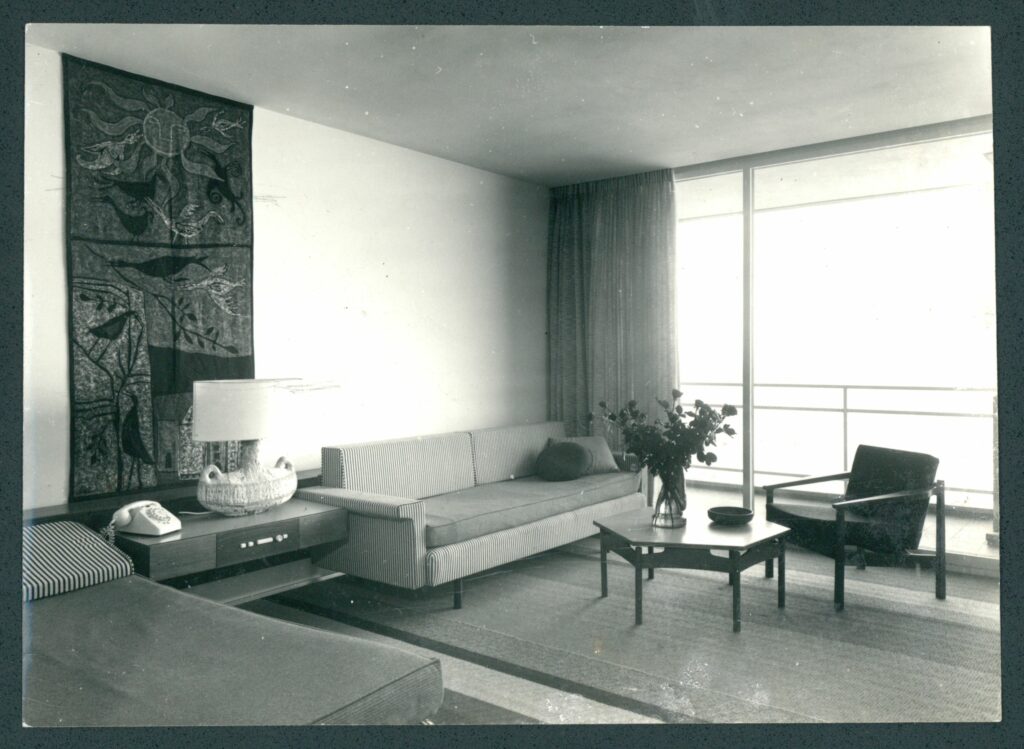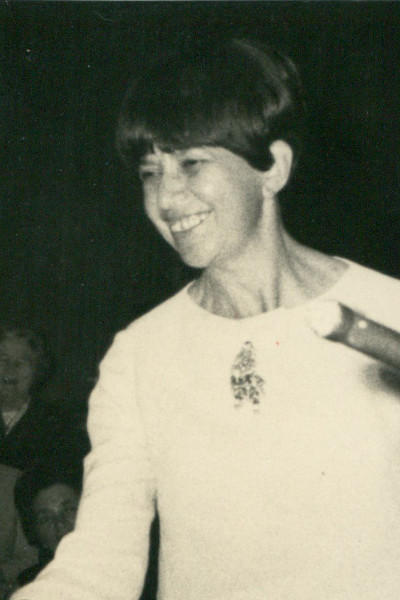


Biography
In Austria, not many people may be familiar with the name Dora but in Israel the architect was one of the best-known and most successful of the 20th century. Many examples of her work can still be found in Israel today. But who was this remarkable woman who completed her training in Vienna?
Dora Gad, née Siegel, was born in 1912, as the daughter of civil servant Baruch Siegel, in Câmpulung, Bukovina, in what is now Romania. At the time of her birth, the town, located almost 170 kilometres north of Bucharest, was still part of the Habsburg monarchy. Family circumstances were difficult, as her father was often absent and unsupportive. The organisation of the family therefore remained mainly in the hands of the mother. Support came from the extended family. Dora seems to have been particularly close to her grandfather, a tailor. Although some members of the family were illiterate, she and her younger brother valued education. Her love of architecture emerged early on, and even though her grandfather was sceptical about her desire to become an architect, she was self-confident enough to believe in her goal. When her grandfather asked her how a woman could be an architect and what she wanted to build, she is said to have replied: Houses, ships and things like that. After finishing school, she moved to Vienna in 1930 and began her studies at the Technische Hochschule Wien (now the Vienna Technical University) in the winter semester of 1930/31.
Only two years later, on 27 February 1933, she passed the 1st state examination and on 17 January 1935 the 2nd state examination. With her diploma under her belt, she first went to Bucharest, where she worked with Duiliu Marcu, one of the best-known Romanian architects at the time. Less than a year leater, she returned to Vienna to marry her former fellow student Heinrich Goldberg.
He had first changed his name to Yehezkel Goldberg after emigrating and later changed his surname to Gad. As he was a convinced Zionist and had received one of the coveted entry visas to the then British Mandate of Palestine, they left Austria for Palestine together in 1936. While the young couple managed to emigrate from Austria in time, other family members were not so fortunate. Her younger brother is said to have become a victim of the Shoah, but we know nothing about the fate of the other family members.
Like many German-speaking architects in exile, both of them found jobs in the offices of other German-speaking architects who had entered the country earlier. Dora Goldberg’s (later Gad) first job opportunity was in the architectural office of Oskar Kaufmann, who had been a sought-after architect in Berlin, especially as a theatre architect, until his emigration in 1933. Her husband joined the office of Alfred Abraham and was thus a colleague of another Austrian architect, Helene Roth, whom we have already introduced here as part of the research project.
By 1938, Dora Gad had already made the leap into self-employment and opened her first office for interior and furniture design. She quickly adapted to new opportunities and developed a light and modern style. Her designs were well received for their simplicity and the use of local materials. Over time, she had developed her own style, which was unmistakably influenced by her Austrian-European training, but was also strongly influenced by the energy of her new home. From the 1950s onwards, Gad increasingly used symbolic motifs in her decoration, with biblical, archaeological and Zionist themes that represented the ideal of the young state. To a certain extent, this became her trademark. At the same time, her artistic language adhered to modern aesthetics and represented the modesty, simplicity and innovative spirit of the young state. Dora Gad attached great importance to integrating Israeli art into the public spaces she designed and to promoting individual artists and Israeli art as a whole. Examples include her hotel interiors, but the public buildings she designed also bear her signature.
In 1942, Yehezkel Gad (formerly Heinrich Goldberg) joined his wife’s office and together they became a sought-after interior design firm in the 1940s and 1950s, realising both private and prestigious public projects, such as the interior of Prime Minister David Ben-Gurion’s residence, the National Library and the EL AL offices. In the first decades after the founding of the Israeli state, Dora Gad played a key role in designing projects for the newly established national institutions, such as the parliament. Even after the death of her husband in 1958, she continued her work, from 1959 in a partnership with her former colleague Arieh Noy, which lasted until 1976. In 1959, she married Ephraim Ben-Artzi, a former general and managing director of the Israeli airline EL-AL. In order not to get into a labour law conflict, she did not accept any more orders for EL-AL equipment after the marriage, at least as long as her husband was managing director of EL-AL.
In 1966, she finally received the prestigious Israel Prize for Architecture for her design of the Israel Museum in Jerusalem. She was the first woman ever to receive this prize. She also received other prizes, such as the Regalo d’Oro Prize and the Yakir Prize from the Council for a Beautiful Israel.
She worked well into old age. In 1994, at the age of 82, the renowned Tel Aviv Museum of Art organised a retrospective of Dora Gad’s successful 50-year career, which she unsurprisingly had conceived herself. Once again, she proved to be a pioneer: to date, no other female architect in Israel has been the subject of a retrospective.
She died in Caesarea in Israel at the end of 2003 at the age of 91.
Works (Selection)
1950: Residences of Prime Minister David Ben-Gurion and Foreign Minister Moshe Sharet, both in Jerusalem
1950-55: Moshe Sharet House
1952: Nahum Goldman House
1955: The Sharon and Accadia Luxury Hotels (Herzliyyah)
1956: National Library in Jerusalem
Israeli embassies in Washington, D.C. and Ankara
1956: The EL AL office in New York
1959: The EL AL office in London
1960-1970: Charles Clore Soldier’s House in Jerusalem
1955 – 1975: The ships of ZIM, the first Israeli shipping line
1958: Hatam Sofer Steet: residential building and architectural office
1965: The Hilton Hotel in Tel Aviv
1965, The Israel Museum
1966, Knesset (Israeli Parliament)
1974: The Hilton Hotel in Jerusalem
1974 House Gad-Ben-Arzi, (her home with her 2nd husband)
1970 and 1974: The EL AL counter at Kennedy Airport in New York
1973: The Ben Gurion International Airport
1980: The Bank of Israel in Jerusalem
1984-1985: The President’s Residence in Rehavia, Jerusalem
1988: Nachtomi House
Prizes
1966: Israel Prize for Architecture with Al Mansfeld for the design of the Israel Museum, Jerusalem
Regalo d’Oro prize in the international prefabricated elements competition organised by Domus magazine
1970: 1st prize in the British Coal Board’s industrial design competition for a prefabricated fireplace
1979: Yakir Prize from the Council for a Beautiful Israel
Sources
AT-TUWA / Archive of TU Wien, main catalogue 1928/1929, Dora Siegel, Matr. Nr. 771-12.12.1930
The National Library of Israel
Mary Pepchinski, Christina Budde, Wolfgang Voigt, Peter Cachola Schmal (ed.): Frau Architekt: Seit mehr als 100 Jahren: Frauen im Architektenberuf, Frankfurt am Main, 2017
Mary Pepchinski, Christina Budde: Women Architects and Politics: Intersections between Gender, Power Structures and Architecture in the Long 20th Century, Bielefeld, 2022
Norgerie Rivas, Episode 41: Dora Gad, in: She Builds Podcast, https://www.shebuildspodcast.com/episodes/doragad
Sigal Davidi: Dora Gad, in: The Shalvi/Hyman Encyclopedia of Jewish Women, 23. June 2021, https://jwa.org/encyclopedia/article/gad-dorah
https://architekturpionierinnen.at/pionierinnen/helene-roth/
Nisha Rathode: Dora Gad, in: Alchetron, https://alchetron.com/Dora-Gad (retrieved 02.02.2024)
https://de.wikipedia.org/wiki/Dora_Gad
Photo: Dora Gad, 1966, © The Dora Gad Archive, at The Israel Architecture Archive (IAA) at The National Library of Israel, reference number: PDoGa-002-034-002
Photo: Knesset, 1966, © The Dora Gad Archive, at The Israel Architecture Archive (IAA) at The National Library of Israel, reference number: PDoGa-002-020-002, Fotograf: Keren Or
Photo: Interior view of the Hilton Hotel in Tel Aviv, 1965, © Israel Museum: The Dora Gad Archive, at The Israel Architecture Archive (IAA) at The National Library of Israel, reference number: PDoGa-002-035-008, Photo Sadeh
Images
Portrait:
Bildunterschrift: Dora Gad, 1966
Text: Christine Oertel
February 2024

